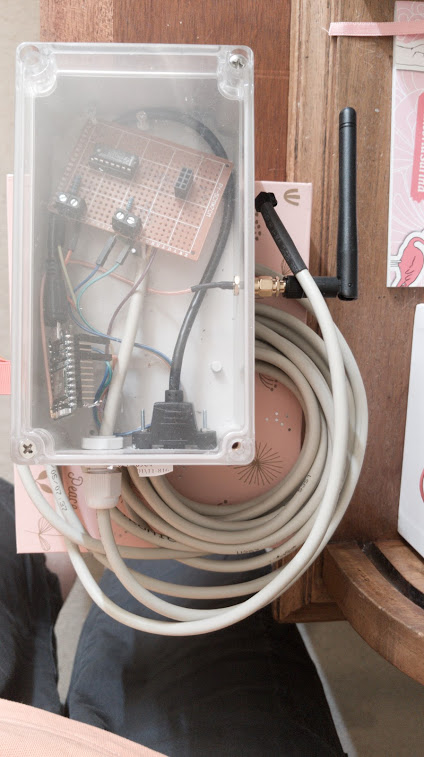as I experienced, MQ sensors are not really gaz sensitive, they are more particle size sensitive when hot enough and when not totally scrap.
I would not rely my life on them, if you have an alcool spray use it around and any MQ will to go the sky...
as I experienced, MQ sensors are not really gaz sensitive, they are more particle size sensitive when hot enough and when not totally scrap.
I would not rely my life on them, if you have an alcool spray use it around and any MQ will to go the sky...
intermediary result: I have started a second gateway and now the nodes do communicate... puzzled...
I remove the extra gateway... same situation...
so reprogram gateway with:
#define MY_RF24_PA_LEVEL RF24_PA_LOW
so it seems this was the responsible for this !
thanks !
will try to put it in debug mode. now I've added a 1u and 100u with no result
Hello,
Today I migrated my gateway from 1.5.1 to 2.3.2, tested it fine.
Then I started trying to reprogram my sensors to 2.3.2 and none works. No wiring changed, previously fine working (CO2, DSM dust sensor)
16 MCO:BGN:INIT NODE,CP=RNNNA---,FQ=16,REL=255,VER=2.3.2
26 TSM:INIT
28 TSF:WUR:MS=0
34 TSM:INIT:TSP OK
36 TSF:SID:OK,ID=20
38 TSM:FPAR
41 ?TSF:MSG:SEND,20-20-255-255,s=255,c=3,t=7,pt=0,l=0,sg=0,ft=0,st=OK:
2050 !TSM:FPAR:NO REPLY
2052 TSM:FPAR
2056 ?TSF:MSG:SEND,20-20-255-255,s=255,c=3,t=7,pt=0,l=0,sg=0,ft=0,st=OK:
3899 TSF:MSG:READ,3-3-255,s=255,c=3,t=7,pt=0,l=0,sg=0:
3904 TSF:MSG:BC
4063 !TSM:FPAR:NO REPLY
4065 TSM:FPAR
4069 ?TSF:MSG:SEND,20-20-255-255,s=255,c=3,t=7,pt=0,l=0,sg=0,ft=0,st=OK:
5923 TSF:MSG:READ,3-3-255,s=255,c=3,t=7,pt=0,l=0,sg=0:
5928 TSF:MSG:BC
6076 !TSM:FPAR:NO REPLY
6078 TSM:FPAR
6082 ?TSF:MSG:SEND,20-20-255-255,s=255,c=3,t=7,pt=0,l=0,sg=0,ft=0,st=OK:
7947 TSF:MSG:READ,3-3-255,s=255,c=3,t=7,pt=0,l=0,sg=0:
7952 TSF:MSG:BC
8089 !TSM:FPAR:FAIL
8090 TSM:FAIL:CNT=1
8092 TSM:FAIL:DIS
8094 TSF:TDI:TSL
Hy there, added an AMS1117 regulator board and a 4,7uF and this works agains ! thanks all for your help !
Hello,
my box:
https://photos.app.goo.gl/MQijz9SK8wBMnic47
can AMS1117 be enough or not powerful enough (I have some).
Not US sadly, but amazon has more stock than local providers as it seems, thanks for the hint !
Hello,
I have a basic arduino pro micro and the 3.3V is from the board. All is directly wired on it (arduino to ebyte module with antenna)
I suspect maybe that the 5V may not be that powerfull, I will enquire (I modified something recently...not sure anymore). Usually it is from phone charger. I've seen I have not changed the gain in the radio too, same code for a long time, my whole network is still in 1.6
I've searched for the ld1117d33 (retired) or its clone, seems difficult to find.
Hello,
I have a water counter that requires a value from the gateway.
So the request is received but the answer is never received as it seems.
Both are with a 5V 1A power generator, toward the arduino mini pro, then the 3.3V directly to the module.
I've looked at the datasheet, I've seen nothing about a capacitor ?
Hi All,
I wanted to use Ebyte nRF24L01P Wireless rf Transceiver E01-2G4M27D 27dBm SPI 2.4GHz with a bif antenna: TX2400-JKD-20 3.0dBi Flexible 2.4GHz RF
But it seems an emission issue on the gateway side where I did put it.
It is directly wired to the arduino.
Any idea ?
maybe check what they did here:
https://github.com/airgradienthq/arduino/blob/master/AirGradient.cpp
thanks for this survey !:
it you remove plastic it is not water proof anymore, and greyscale was not precise enough....
CNY70 has reflexion protection which is much better
not with mysensors, but could have been: CNY70 water sensor meter (rotating wheel) with extended wifi range, the heart of it is a Particle Photon pushing to domoticz

here is a link with the schematics (so simple !):https://easydomoticz.com/forum/viewtopic.php?f=17&t=1737&start=70
Hello,
I've dropped this approch to use the CNY70 ir on this water meter.
I did that for a friend that has not the mysensors gateway (range issue) so I made it with a Particle Photon using a wifi extender, but it is quite straightforward reading the pulse up and down.
MQ are always a bad choice, saturate air around with any gas and they will react ...
Mics are used by sensely, but even them aren ot calibrated... and they are a hell to get working even when you have the pins soldered to them.
@lukács-attila check wiring first, seems there are several sub version around thay may need other values from datasheet
@ambuj please see the begining of the discussion regarding MQ like reliability
@gohan I would have too much work going to 2.0 on every node I have, but I have to do this as a background task since I'll have to upgrade all my sketches first...
swapping hardware is an option, recabling everything is not my cup of tea ;-)
Hello,
I am trying to get my sensors back, and I have one that goes off the road several time...
board is a uno, with long antennae, mysensors lib is 1.5.
send: 3-3-0-0 s=255,c=0,t=17,pt=0,l=5,sg=0,st=fail:1.5.1
send: 3-3-0-0 s=255,c=0,t=17,pt=0,l=5,sg=0,st=fail:1.5.1
sometime resetting the uno button is enough, other not, and unpowering several times is the only way to make it work. BTW is is less than 1m from the controller.
sometimes, it goes well for 2h, then I have a 'fin parent' message on console and hten everything fail after.
any idea ?